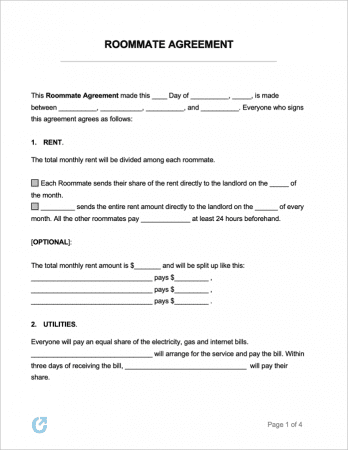Roommate Agreement Template
A roommate agreement template, also called a “roommate lease agreement”, is a document used for establishing a set of formal and informal rules that tenants sharing a rented apartment, home, or condominium agree to follow for the length of the lease.
It is mainly used to reduce the likelihood of disagreements forming over noise, guests, cleaning, utility payments, belongings, and similar topics. The mere act of discussing and completing a roommate agreement is often as important as the contract itself, as many roommates find it difficult to bring-up rules after the first few weeks or months of living together.
College (Dorm) Roommate Agreement – specifically designed for students sharing the same university dorm room or apartment.
Roommate Agreements by State
The following states contain state-specific roommate agreements, which were designed to account for each state’s unique lease laws.
- Alabama
- Alaska
- Arizona
- Arkansas
- California
- Colorado
- Connecticut
- Delaware
- Florida
- Georgia
- Hawaii
- Idaho
- Illinois
- Indiana
- Iowa
- Kansas
- Kentucky
- Louisiana
- Maine
- Maryland
- Massachusetts
- Michigan
- Minnesota
- Mississippi
- Missouri
- Montana
- Nebraska
- Nevada
- New Hampshire
- New Jersey
- New Mexico
- New York
- North Carolina
- North Dakota
- Ohio
- Oklahoma
- Oregon
- Pennsylvania
- Rhode Island
- South Carolina
- South Dakota
- Tennessee
- Texas
- Utah
- Vermont
- Virginia
- Washington
- West Virginia
- Wisconsin
- Wyoming
Types (2)
 Standard Roommate Agreement – used for the majority of roommate living situations. Allows for the establishment of rules, quiet hours, cleaning schedules, guest policies, and much more.
Standard Roommate Agreement – used for the majority of roommate living situations. Allows for the establishment of rules, quiet hours, cleaning schedules, guest policies, and much more.
 Utility Roommate Agreement – a roommate agreement with sections that allow rules to be made regarding specific utilities such as internet, cable, security deposits, and general utility bills.
Utility Roommate Agreement – a roommate agreement with sections that allow rules to be made regarding specific utilities such as internet, cable, security deposits, and general utility bills.
Download: PDF
What is a Roommate Agreement?
A roommate agreement is a document designed to promote structure and harmony within a shared living space. This agreement can be employed to establish guidelines on matters such as guests, chores, utilities, alcohol and drug use, and rent payments.
When roommates officially sign the document, outlining their responsibilities for rental payments and/or utilities, it can serve as a legally enforceable instrument.
Roommate Agreement FAQ
Is a roommate agreement legally binding?
It depends. If 1) the tenants signed and dated the agreement, and 2) the contract contains rules on rent payments and utilities, then the agreement can be legally binding. However, only conditions regarding money can be enforced by a court of law.
For example, if a roommate by the name of “Jimmy” keeps inviting his friends over at 1 AM to practice the drums, a court can’t force Jimmy to stop playing the drums or find better friends – that’s up to the roommates to resolve.
Are roommate agreements and leases different?
Yes, very much so. Leases structure every detail regarding a rental arrangement and bind the landlord and lessees to a set of conditions that, if broken, can follow severe consequences. Roommate agreements, while serious documents, only apply to the tenants themselves – the landlord does not have to know a roommate agreement even exists during the lease.
What should be included in a roommate agreement?
Generally, as much detail as possible should be included. Even if it is never referenced again, having as much agreed-upon beforehand can prevent future conflicts from escalating into more serious fights. If all the roommates are on the lease agreement signed with the landlord, including rent payments is not necessary. This also applies to utilities. However, if the original lease does not specify which roommate is to pay what, or it doesn’t say utilities and rent is to be split evenly, this should be included on the roommate agreement.
What to Include
- Rent and Security Deposit. Specify each roommate’s share of the rent, security deposit, and the due date for payments.
- Utilities and Bills. Allocate responsibility for various utility and service bills, such as electricity, gas, water, internet, and cable.
- Lease Duration. Define the start and end dates of the agreement, as well as the procedure for early termination or lease renewal.
- Household Chores. Establish a weekly or monthly cleaning schedule and designate responsibilities for shared spaces like the kitchen, bathroom, and living room.
- Quiet Hours. Set guidelines for acceptable noise levels during designated quiet hours to maintain a peaceful living environment.
- Guests and Visitors. Outline policies regarding overnight guests, the frequency of visitors, and any restrictions on gatherings or parties.
- Shared Expenses. Determine how to handle shared household expenses, such as groceries, cleaning supplies, and maintenance costs.
- Personal Property. Clarify the rules surrounding using and caring for each roommate’s personal belongings.
- Conflict Resolution. Establish a process for addressing disagreements and resolving disputes among roommates.
- Modifications to the Agreement. Detail the procedure for amending the agreement, if necessary, and obtaining consent from all roommates.
- Move-out Procedure. Specify expectations for moving out, such as providing advance notice, finding a replacement, and handling the return of security deposits.
